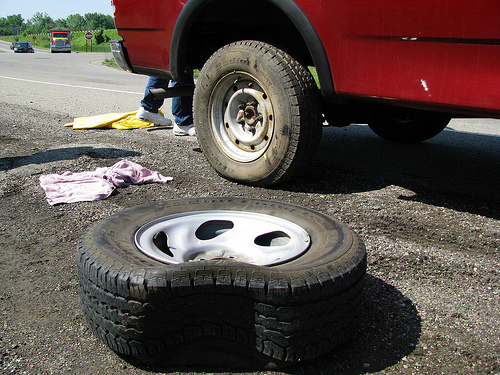Our vehicles do a lot for us everyday. They get us from point A to point B, they are a place where we make memories with friends and family, they show off our personal style. We rely on our vehicles everyday, but they also rely on us to keep them maintained and in good working condition.
 One part of the car that gets the most wear and tear is the tires. Without these four round tubes of rubber our vehicles wouldn’t make it very far. Fortunately, this is one of the easiest things to maintain on your car so you catch problems before they land you on the side of the road.
One part of the car that gets the most wear and tear is the tires. Without these four round tubes of rubber our vehicles wouldn’t make it very far. Fortunately, this is one of the easiest things to maintain on your car so you catch problems before they land you on the side of the road.
Checking the Tire Tread
Even if you aren’t a master mechanic you can still identify problems with your tires if you know what to look for and what different types of wear patterns mean. Use this quick checklist to determine if your tires or car are in need of repair.
- Toe Wear – If the inner or outer portion of the tire is more work than the rest of the tread this is called toe wear. This is usually caused by the car being out of alignment.
- Camber Wear – Similar to toe wear but more extreme, camber wear can occur when the tire leans inward or outward causing heavy wear on the inner or outer portion of the tire. This indicates there may be problems with a strut, spring, spindle, control arm brushing or the suspension.
- Center Wear – If the center of your tire tread is more worn than the sides this is indicative of an overinflated tire. The proper pressure should be listed on the side of the tire so that you can make the necessary adjustments.
- Outer Edge Wear – If both outer edges are more worn than the center under inflation is most likely the problem. Again, use the pressure listing on the side of the tire to gauge proper inflation when airing the tires up.
- Patchy Wear – If there are patches of wear in different spots the tires are likely out of balance. To help equalize the wear have the tires spun and rotated by a mechanic.
- Cupping Wear – If you see diagonal grooves this indicates a more serious issue in the suspension of the car. It should be brought into a mechanic to be checked out ASAP.
- Normal Wear – If your tread is wearing evenly across the whole tire this is considered normal wear. It’s not uncommon for the front wheels to wear faster on front-wheel drive vehicles and for the back tires to wear quicker on rear-wheel drive vehicles.
Tires should be checked regularly to ensure there is no abnormal wear occurring. Getting your tires rotated every 5,000-8,000 miles (or as suggested in your vehicle’s owners manual) will help to keep tires wearing evenly.
Checking the Tire Pressure
As stated above the tire pressure can have a serious effect on the performance of the tire and the wear that it receives. Too much or too little pressure can cause the tires to wear out faster, affect fuel efficiency and lead to safety concerns.
Getting the tire pressure just right only takes a few minutes and is easier than you may think. All you need is an inexpensive air gauge that measures pounds per square inch and an air source, which you should be able to find at most gas stations.
Step 1. Take the time of year into consideration. The temperature outside and current weather conditions are going to affect how much air pressure you need. When it’s cold out the air pressure drops so you may need to be more diligent about keeping tires aired up during the winter months.
Step 2. Check the air pressure when the tires are cold. If you’ve been driving more than a mile or tw on the tires they are going to warm up, which causes them swell.
Step 3. Figure out the proper PSI. There are several ways to find out what PSI is best for your vehicle’s tires. The information can be listed in your owner’s manual, the driver’s side door or on the tires themselves. Never go 5 PSI above or below the recommended amount.
Step 4. Check the PSI. Place the gauge on the tire’s valve stem, which is located on the side of the tire. Press the gauge firmly into the valve. This will cause air to release momentarily, but as soon as it is fully within the valve the airflow will stop and you’ll get a reading. Check the pressure of all four tires, and note which ones need air.
Step 5. Adjust the Tire Pressure. Before dropping a few quarters in the gas station air machine remove the caps on all four tires. When adding air fit the nozzle completely over the stem. Air will escape until the nozzle is firmly in place. If the nozzle has a handle squeeze it in to add air to the tires. Remove the nozzle frequently to check the pressure with the gauge until you get within 5 PSI of the ideal amount. Once all four tires are properly aired up replace the caps and you’re good to go!
Properly maintaining your car is an important part of keeping safe on the road. And driving safe is the best way to keep your car insurance rates as low as possible. Give us a call today to discover more ways to keep your premiums low.
Image Source: http://www.flickr.com/photos/rpstanton/3125309175/
Original Source: http://www.mybiginsurance.com/auto-insurance/check-tires-wear-air

